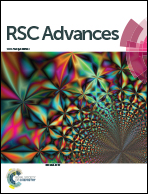Preparation of binder-free CuO/Cu2O/Cu composites: a novel electrode material for supercapacitor applications
Abstract
Cuprous(I) oxide (Cu2O) carries high theoretical specific capacitance (2247.6 F g−1), however, the amount of research about the supercapacitive performance of Cu2O is relatively small compared with other transition metal oxides. A composite of metal and metal oxide could improve the electrochemical performance efficiently. In this work, the results of XRD and XPS demonstrate that CuO/Cu2O/Cu is prepared successfully via a facile, eco-friendly, one-step template-free growth process. SEM figures show that cubic CuO/Cu2O/Cu uniformly and densely covers a skeleton of nickel foam. The binder-free CuO/Cu2O/Cu electrode exhibits excellent supercapacitive performance with a high specific capacitance of 878 F g−1 at a current density of 5 mA cm−2 (1.67 A g−1), when the current density is enlarged ten times (50 mA cm−2 (16.7 A g−1)), the specific capacitance still remains at 545 F g−1. Furthermore, we have first successfully constructed a CuO/Cu2O/Cu//AC asymmetric supercapacitor, which can achieve an energy density of 42 W h kg−1 at a power density of 0.44 kW kg−1. The good electrochemical performance and simple accessibility prove that the as-prepared CuO/Cu2O/Cu/NF electrode has a potential application in electrochemical capacitors.


 Please wait while we load your content...
Please wait while we load your content...